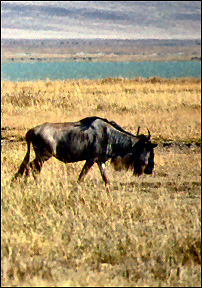Wildebeest Biology
 There are two species of wildebeest, both in Africa. The black wildebeest (Connochaetes gnou) is less common, and occurs in southern Africa.
We are studying the white-bearded wildebeest (Connochaetes taurinus), sometimes called the blue wildebeest and common in East Africa. Wildebeest are grazers, allies of antelope, cattle, and other even-toed hooved animals. The populations we study include a few thousand animals, but in the Serengeti Ecosystem, more than one million animals occur.
There are two species of wildebeest, both in Africa. The black wildebeest (Connochaetes gnou) is less common, and occurs in southern Africa.
We are studying the white-bearded wildebeest (Connochaetes taurinus), sometimes called the blue wildebeest and common in East Africa. Wildebeest are grazers, allies of antelope, cattle, and other even-toed hooved animals. The populations we study include a few thousand animals, but in the Serengeti Ecosystem, more than one million animals occur.
Wildebeest are well adapted to long-range movements and fending off enemies, but they do look clumsy. Their bodies are muscular, with large front quarters, disproportionally small hind quarters, and thin legs. They are generally brownish to grey, sometimes almost silver, with dark faces and long black tails. Both males and females have horns, flattened near their heads, coming out away from their face and then bending up and in, to form points. Adult males may be 165 to 290 kilograms (364 to 639 pounds), with females somewhat smaller, and males have larger and more robust horns than females. Calves are redish, with dark heads and a dark strip down their back.
Wildebeest live in savannas, grasslands, shrublands, and open forests, often in the company of other grazers such as zebra and gazelles. Wildebeest form small or large groups. In the breeding season, one or a few males will form a territory, and gather females into groups. They will defend that group from other males, chasing, snorting. and sometimes fighting to maintain dominance. After breeding season, the animals join larger groups. Some wildebeest are residents, meaning that they do not move very much from season to season. Other groups are migratory. The most dramatic example is the Serengeti animals, which migrate hundreds of kilometers each year. The animals we study migrate shorter distances. In general, animals scatter during the wet season, and then come together in the dry seasont to use permanent water sources. Wildebeest need water every day or two, and so do not tend to occur in areas where water is more than 20 or 25 kilometers away.
These animals are famous for what is called synchronous breeding. Courtship and mating occur in the span of a few weeks. Eight-and-a-half months later, the females all give birth in a short period. This is thought to be an adaptation to 'swamp' predators with calves, so that some are lost, but so many calves are born at once that most survive. The calves are precocial, meaning that they are ready to stand within a few minutes of birth, and can keep up with the herd in a few hours.
Wildebeest are sometimes taken by lions, cheetahs, leopards, and hyenas, especially the young wildebeest. When drinking, wildebeest are particularly cautious - their water source may contain crocodiles, which surge out of the water and grab unsuspecting animals.










